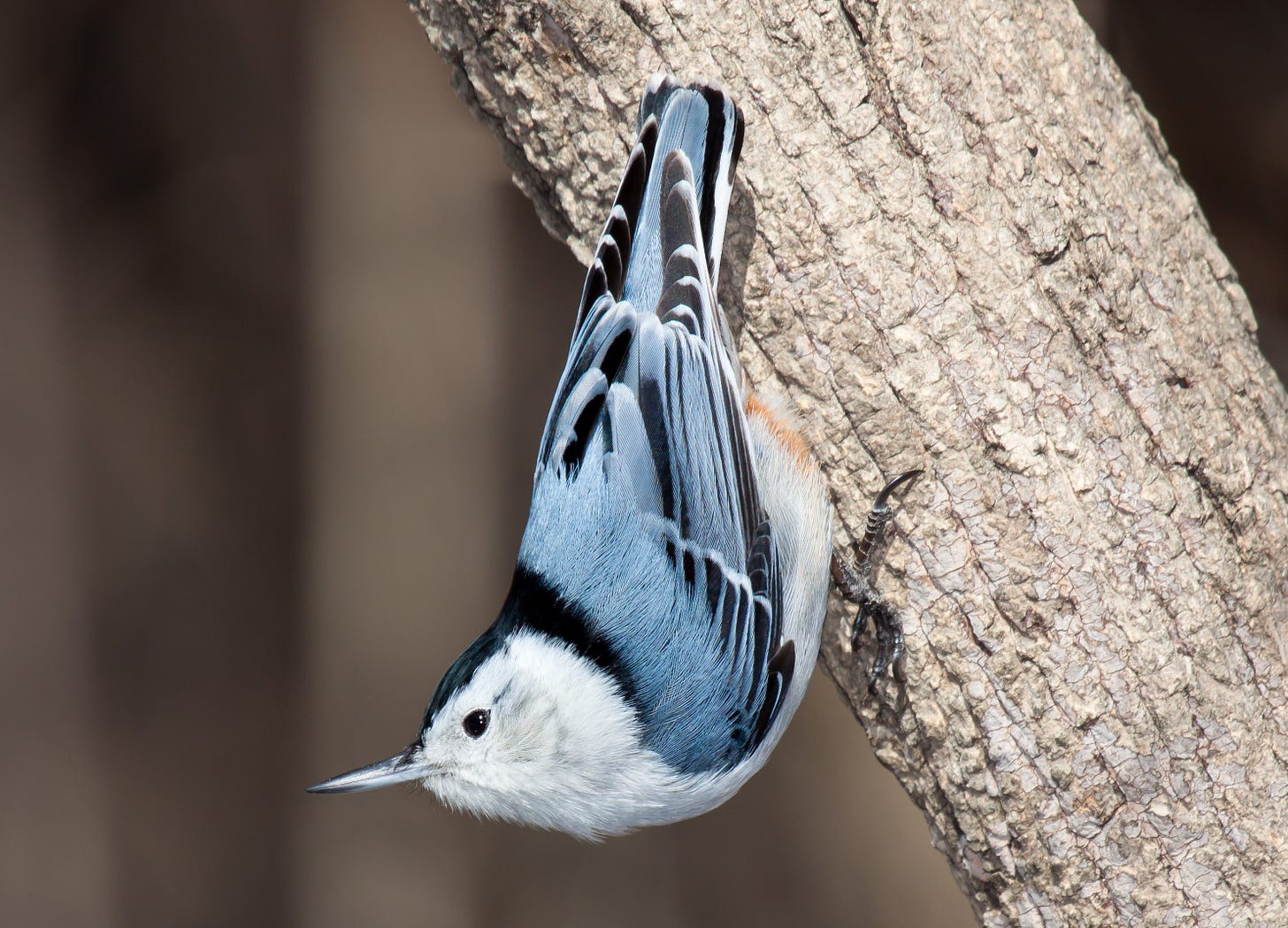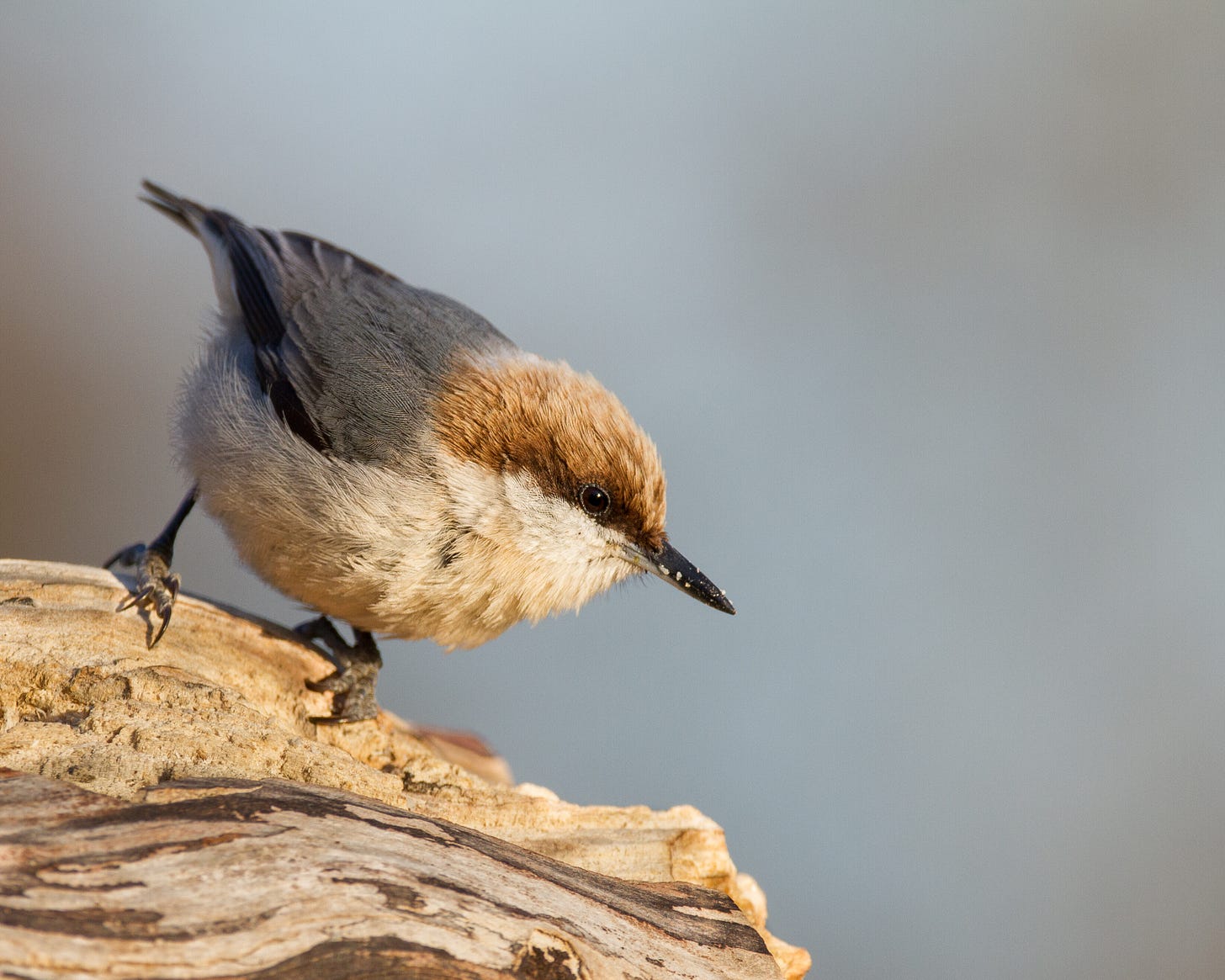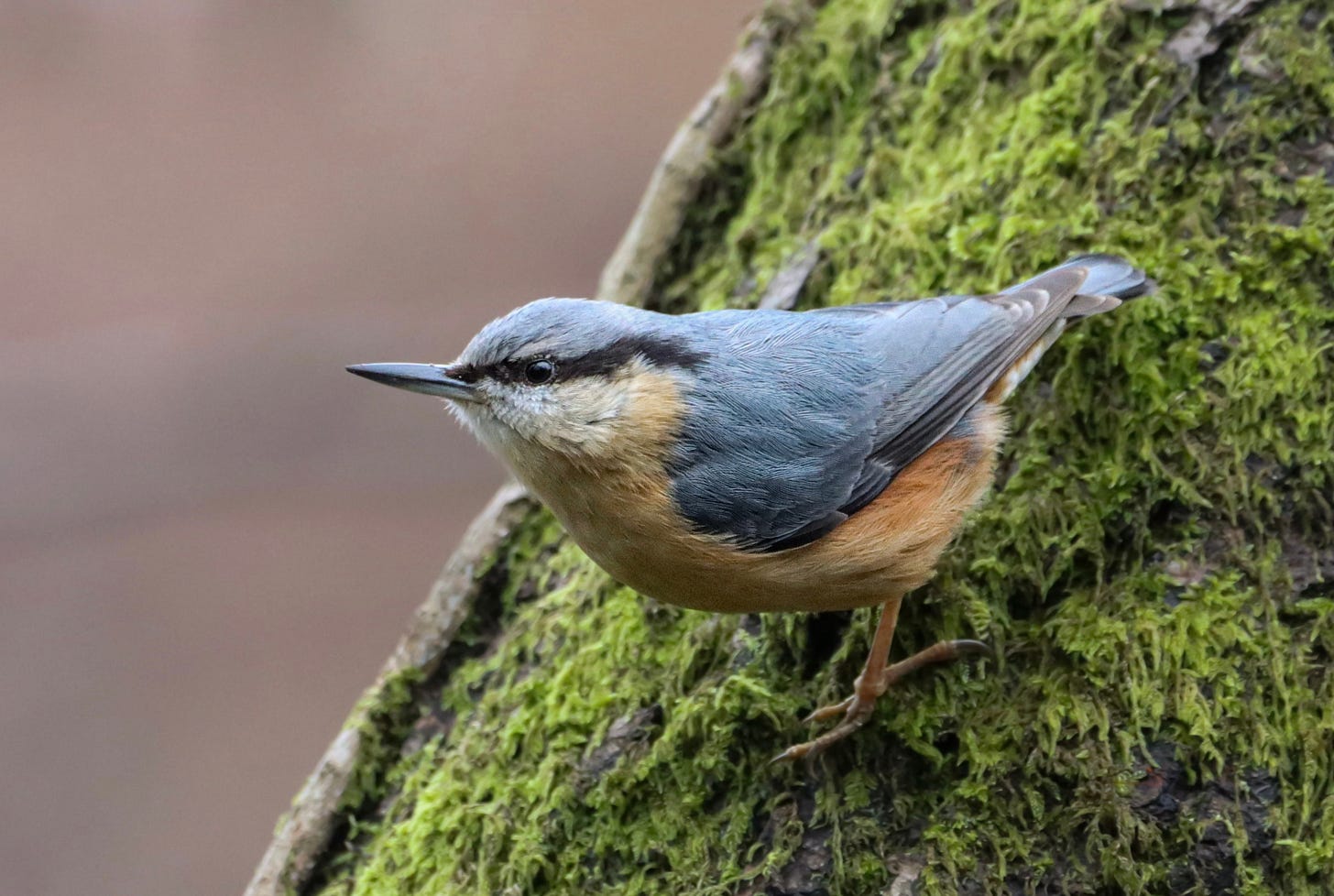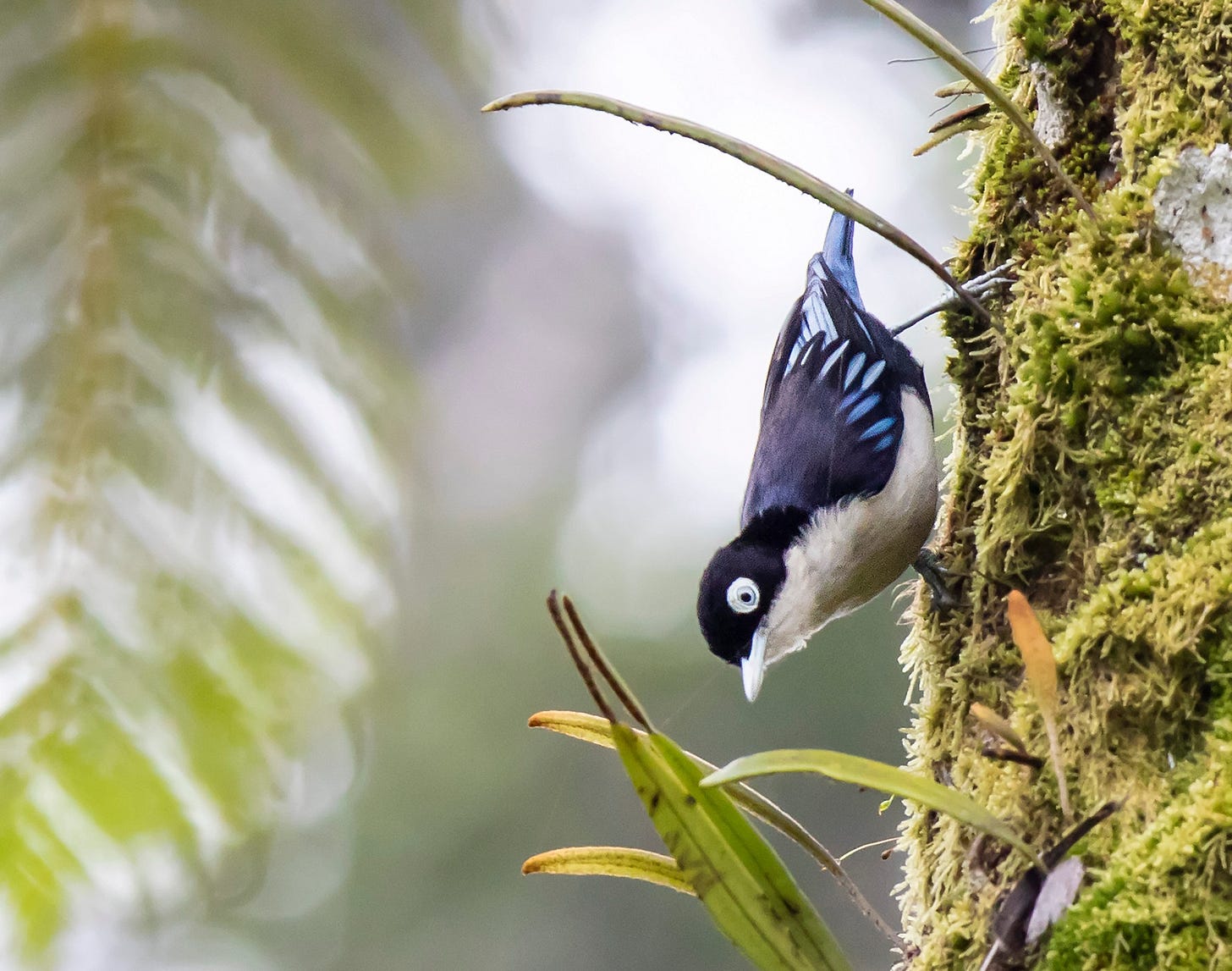UPDATES & ANNOUNCEMENTS
1.) MARK YOUR CALENDARS: This Saturday, October 18, we’re migrating to Central Park.
Meet us at 10:15 AM, on 5th Ave between 72nd and 73rd St.
So yep — no regular McGolrick Park outing this week.
More details soon here and on Instagram.
2.) MISS OUT ON OUR LAST DROP? A few metal tees survived the blitz in our family + friends emergency stash. DM us to check color/size.
TYPE: NUTHATCH
Previously, on Mid-Microseason Bird Lessons: wrens and thrashers duked it out for world’s drippiest bush dweller.
Today’s episode: our story creeps upward as we meet: THE NUTHATCHES.
Nuthatches are cool because they’re easy to notice. Stubby little guys—wren-shaped and wren-sized—but instead of cocked tails and skulky habits, look for creepy movements along bark plus robust, pointy, sorta upturned bills.
I write creepy because these birds actually do it. They forage for hidden snacks by shuffling along trunks and branches, literally creeping, sometimes upside-down.
That last habit earned nuthatches the dubious honor of gracing the cover of The Field Guide to Dumb Birds of North America. While that book is well-meaning—and we do appreciate irreverent hahas, especially in this darkly comic age—any media that diminishes the spiritual triumph birding contains is The Noticer’s sworn enemy…
Nuthatches are omnivorous, but their signature move—wedging a nut into a crevice, then hammering it open with that baddie bill—is what gives the group its English name.
Nothing dumb about that tactic, is there, author Matt Kracht? We shout in that petulant, pretending-not-to-be-emo-injured, schoolyard patois.
NUTHATCHES TO KNOW
4 nuthatch species are noticeable in the U.S.
2 of them—the first two, below—are found virtually nationwide, including in New York City.
The most noticeable nuthatch species in North America. In Brooklyn, they’re out and about year-round, most so (a) in winter and (b) in larger green spaces like Prospect Park.
McGolrick, our sweetheart urban forest petri dish and stand-in for other neighborhood NY parks, only hosts them some winters, probably due to irruption, an irregular migratory thing that you can read more about here.
Look: Blue above, clean white face and belly, black cap, and just a blush of rust under-tail. (Photos here.)
Oft-heard sound: Clown nose honks.
Favorite allaboutbirds.org fact: “In winter, White-breasted Nuthatches join foraging flocks led by chickadees or titmice, perhaps partly because it makes food easier to find and partly because more birds can keep an eye out for predators. One study found that when titmice were removed from a flock, nuthatches were more wary and less willing to visit exposed bird feeders.”
The other nationwide nuthatch is less noticeable than the White-breasted, and more of an exclusive winter visitor to New York City and other low-lying regions.
They’re uncommon in McGolrick Park—we’ve only seen them three times, most recently on our October 4th Bird Club outing ✌️. Still, a recent trip to Prospect Park, where Red-breasteds were everywhere, has me wondering if this might be a big year for them in NYC.
Look: Crisp black-and-white head stripes, blue-gray above, warm cinnamon below. The key to noticing a Red-breasted is that dramatic, isolated black eye-stripe—it’s giving Pris in Blade Runner. (More photos here.)
Oft-heard sound: Clownish honks, but like, on helium.
Favorite allaboutbirds.org fact: “During nesting season, they smear sticky sap around the nest’s entrance hole, possibly to deter predators—or nosy neighbors.”
3.) Pygmy Nuthatch
One of the first western species I (Michael) noticed as a budding San Francisco birder.
Look: Soft gray-blue above, off-white below, with a neat gray cap. True to name, the smallest nuthatch. (More photos here.)
Oft-heard sound: Peeps.
Favorite allaboutbirds.org fact: “No records exist of Pygmy Nuthatches roosting alone. They always huddle in groups. In the 1950s, a biologist watched 150 pile into one tree—100 in a single hole.”
Range: a pine-bound archipelago across the West and Mexico. See:

The southerner.
Look: Soft brown cap meets slate-gray back. Pale below. White patch on the back of the neck. Dab of sunscreen type s--t. (More photos here.)
Oft-heard sound: Rubber ducky.
Favorite allaboutbirds.org fact: “One of the few North American birds known to use tools—prying bark with flakes of pine to find hidden insects.”
Range: Found in southeastern pine woods from the Chesapeake down into the Carolinas all the way to Florida and East Texas. Observe:

INTERLUDE: SO I CREEP 🎺
Nuthatches and only two other U.S. species creep.
So if you see a bird sneakily touching up bark, it’s the zebra-striped Black-and-white Warbler, the (ahem) brown Brown Creeper, or a Nuthatch.
(Woodpeckers come close, but are really more cling-hop-clingy than creepy.)
UNAMERICAN NUTHATCHES
If you ever find yourself fleeing our dumb, stateside version of emergent fascism—say, wandering Europe or Asia—you’ll likely meet the Eurasian Nuthatch.
Its range streeetches from the British Isles to Morocco, then east through Russia, Japan, Korea, and Taiwan.
My favorite nuthatch of all? The Blue Nuthatch of the Malay Peninsula. Blue Jay back and chameleon-ass eye. Fly to Sumatra and notice one—right now—or else.
HOW TO NOTICE A NUTHATCH IN NYC
Search iNaturalist for sightings near you. Or, go pure: just head to a large park, follow your instincts to the wildest zones and most delicious-looking bark within them.
Deeply listen for those clown-nose HONKs.
Move around and scan trees efficiently. Nuthatches creep constantly, hopping from one crevice to the next, and when present, are not hard to notice.
Once you spot a creeping bird, rule out the Brown Creeper and the Black-and-white Warbler, then look for the White-b’s clean face or the Red-b’s bold brow.
In convivial reverie, eat a bug.











